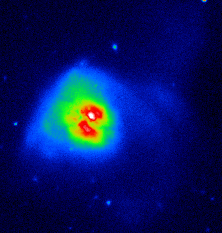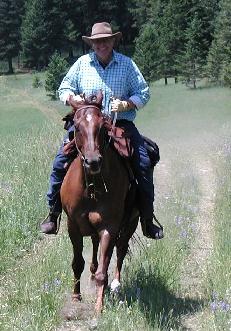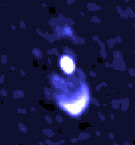 |
Harding E. (Gene) Smith |
 |
| Professor of Physics |
Center for Astrophysics & Space Sciences
and Physics Department, UCSD |

Research Interests:
Extragalactic observational astrophysics; galaxy formation and evolution;
Quasars and Active Galactic Nuclei; Luminous Infrared Galaxies;
Observational Cosmology.
Students interested in astronomy as a career - you can read about
How I became an Astronomer.
Education/Employment:
- BS - Caltech 1969
- PhD - UC Berkeley 1974
- Postdoctoral Fellow - UCSD 1974-77
- UCSD Faculty - 1977-Present.
- Also Visiting Research Scientist,Infrared Processing and
Analysis Center, Caltech
(IPAC), Caltech/JPL.
 ,
,
Recent Work:
The Starburst-AGN Connection
Recently we have been studying the connection between AGN and Starburst
Galaxies by observations of Luminous Infrared Galaxies at Optical, Infrared
and Radio wavelengths. We have used VLBI techniques to show that high
brightness temperature, radio cores are common in Luminous infrared
Galaxies and that there is a common relation between Radio Power and
Bolometric Luminosity for Luminous Infrared Galaxies and Quasars. A
plausible case may also be made that these galaxies are Starbursts with
activity on immense scales. We are attempting to determine which objects
may be bona-fide AGN and which are Starbursts and whether there may be an
evolutionary connection between the two. This is a family project with
Dr. Carol J. Lonsdale, IPAC, Caltech, and Dr. Colin J. Lonsdale, Haystack
Observatory, MIT (who also happen to be my wife & brother-in-law) and Dr.
Philip J. Diamond of the NRAO.
The Intense Starburst in Arp 220
The image above is a false color r-band image of the Luminous Infrared
Galaxy - Arp 220 (Courtesy D. Sanders & D.C. Kim, MaunaKea). This galaxy
has a quasar-like luminosity coming from a dust-enshrouded central core
which represents the strongly interacting nuclei of a pair of merging
galaxies. We have demonstrated that Arp 220 has a compact radio emission
and OH maser emission from a surrounding molecular cloud which must
be smaller than a few pc in size. The compact radio emission comes from
luminous radio supernovae (See our
VLBI Radio Map of the NW nucleus) indicating that Arp 220 is forming
stars at a rate of about 100 solar masses per year.
New work involves mid-infrared imaging and spectroscopy of Luminous
Infrared Galaxies with UCSD's Long Wavelength Imaging Spectrometer
(LWS) on the Keck Telescope as well as
further VLBI studies of Luminous Infrared Galaxies in
the continuum and OH maser emission. Click on the image above
to view a larger scale image, or you can view a composite
HST
image (nearly 1Mbyte).
The Birth of A Quasar in Markarian 231
 |
New radio images of the Luminous IR Galaxy Mrk 231 show a compact
quasar-like radio core surrounded by a disk of molecular gas. The
molecular disk, shown in our
OH maser image,
is a ring of intense star formation. Our high-resolution
radio image shows
the quasar core plus a bright radio lobe where a jet of rapidly streaming
particles is plowing into clouds of molecular gas. The jet itself is
invisible in this image, but you can observe what's happening here in an
MPEG animation produced by
IPAC's Robert Hurt. The timescale for "ram pressure" to move outward from
the central core suggests that the quasar is quite young, less than a
million years old. Although a quasar has "turned-on: in Mrk 231, about 2/3
of its energy still comes from star-formation. We believe that Mrk 231
is an example of a system in which the merger of two gas-rich spiral galaxies,
shown in this simulation from
the IMAX Movie
Cosmic Voyage
, stimulates an intense Starburst, which
in turn feeds the coalescing black hole in the galaxy's center. As this black
hole accretes material, the gravitational energy which is released powers a
newly-formed quasar which will eventually blow the dust and gas away from the
nucleus, revealing itself at wavelengths from gamma-rays to radio.. |
You can also view the
HST image from Surace
et al. 1998.
For a long time we've been working on galaxy evolution in the infrared
(see ISO-IRAS Faint Galaxy
Survey, for example). In November 2000, our team, led by PI Carol
Lonsdale, was selected to undertake the largest survey with NASA's
Space InfraRed Telescope Facility -
SIRTF.
SWIRE is a wide-area, high galactic latitude, imaging survey to trace the
evolution of dusty, star-forming galaxies, evolved stellar populations, and
active galactic nuclei as a function of environment from redshifts, z ~ 3,
when the Universe was about 2 billion years old, to the present
time. SWIRE will survey approximately 70 square degrees with the
MIPS far-infrared
camera and the with the
IRAC mid-infrared camera.
The key scientific goals of SWIRE are to determine:
-
The evolution of both actively star-forming and passively-evolving galaxies
to determine the history of galaxy formation (including the global Star
Formation History - SFH), in the context of cosmic structure formation and
galaxy environment.
-
The spatial distribution and clustering of evolved galaxies, starbursts,
and AGN, and the evolution of their clustering in the key redshift range
from 0.5 < z < 3 over which much of cosmic evolution has occurred.
-
The evolutionary relationship between galaxies and AGN, and the
contribution of AGN accretion energy to the cosmic backgrounds, relative
to that from nucleosynthesis.
The survey will be dominated by: (1) more than 105 luminous
infrared galaxies (log LFar-IR > 1011
L ); up to 40,000 with z > 2.
(2) 1 million early-type galaxies; up to 400,000 with z > 2.
(3) 30,000 classical AGN, and as many as 250,000 dust-obscured QSO/AGN.
); up to 40,000 with z > 2.
(2) 1 million early-type galaxies; up to 400,000 with z > 2.
(3) 30,000 classical AGN, and as many as 250,000 dust-obscured QSO/AGN.
The satellite data will be complemented by an extensive program of
ground-based optical, near-infrared and radio observations, providing
identifications, photometric-redshifts, spectral energy distributions and
other physical information. All of the survey data will be available to
the Astronomical Community through the NASA/IPAC
Infrared Science Archive.
Physics/Astronomy Education:
I am also concerned with Physics & Astronomy Education. I have worked on
courses associated with the COSMOS and
Understanding Space and Time
television series and on the new telecourse
Universe: The Infinite Frontier.
I have also been a participant in UCSD's Science Teacher Institutes and in the
development of Physics and Astronomy courses at UCSD. Here is ou
Public Outreach & Education site
with an Astronomy Tutorial that I developed.
This research high-lighted on this page has been supported by the US National
Science Foundation. Additional
support for the ISO-IRAS Faint Galaxy Survey has been provided by NASA.
Publications:
Here are selected recent & relevant publications.
Teaching:
This quarter I'm teaching "
Physics 11,
"Survey of Physics" for Revelle College liberal arts majors.
Last Updated March, 2001
Created and maintained by
Gene
Smith
You may also contact me at
CASS 0424, UCSD
9500 Gilman Drive
La Jolla, CA 92093-0424
(858) 534-4558
 UCSD Campus WWW Server
UCSD Campus WWW Server
 Back to the CASS Home Page
Back to the CASS Home Page
 Physics Dept Home Page
Physics Dept Home Page





 ,
,

 ); up to 40,000 with z > 2.
(2) 1 million early-type galaxies; up to 400,000 with z > 2.
(3) 30,000 classical AGN, and as many as 250,000 dust-obscured QSO/AGN.
); up to 40,000 with z > 2.
(2) 1 million early-type galaxies; up to 400,000 with z > 2.
(3) 30,000 classical AGN, and as many as 250,000 dust-obscured QSO/AGN.
 UCSD Campus WWW Server
UCSD Campus WWW Server
 Back to the CASS Home Page
Back to the CASS Home Page
![]() Physics Dept Home Page
Physics Dept Home Page